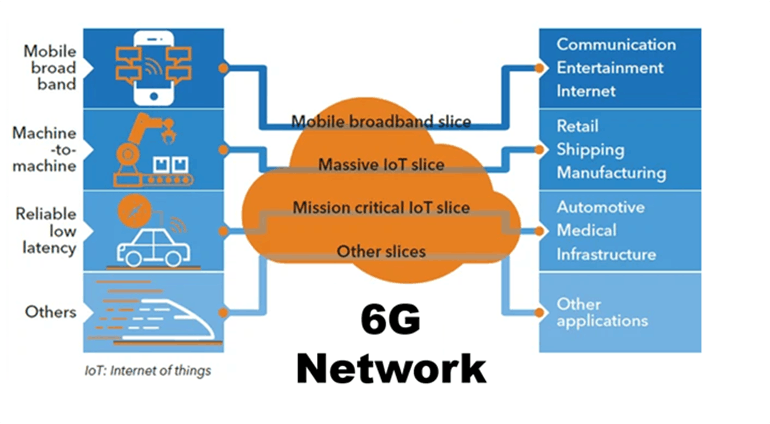 According to IBM, “A digital twin is a virtual representation of an object or system that spans its lifecycle, is updated from real-time data, and uses simulation, machine learning and reasoning to help decision-making.” The express purpose of digital twins is to control the physical version of the twin.
According to IBM, “A digital twin is a virtual representation of an object or system that spans its lifecycle, is updated from real-time data, and uses simulation, machine learning and reasoning to help decision-making.” The express purpose of digital twins is to control the physical version of the twin.
Furthermore, 6G will more fully enable and facilitate the creation of digital twins for complex systems, buildings, cities and people. — Technocracy News & Trends Editor Patrick Wood
By: Dr. Rajive Bagrodia via Electronic Design
Even as 5G cellular network deployments continue to ramp up within the U.S. and worldwide, major academic programs, research institutes, and commercial R&D operations are turning their focus toward deeper investigations into the promise and realization of 6G technology. Significant government investments have already occurred, and they’re expected to increase dramatically over the next few years. Nations are jockeying for a leadership position in 6G for both commercial and military use cases and seeding early explorations into technology and applications.1
The significant expansions anticipated in all of the usual metrics of cellular communication, including capacity, latency, device density, connection reliability, and other technology growth markers, is well documented.2 Also noteworthy is the burgeoning growth in the number and diversity of devices coming online via the rapidly expanding IoT.
Of course, to name a few areas of substantial growth, these will require significant technology breakthroughs in chipset design, antenna technology, ML-embedded networking, and real-time machine learning.

However, from a broad-based business and consumer perspective, the major impact of 6G is expected to be in the design, deployment, and widespread adoption of a bevy of novel applications that exploit these substantial technological breakthroughs (see figure). Some of the applications being discussed include holographic telepresence, remote surgery, deployment of an autonomous fleet of unmanned vehicles, and deep space or deep ocean exploration.3
The 6G technology breakthrough will need to meet a consistent, predictable, and demanding set of service level agreements (SLAs) to support such diverse applications while adapting to an unprecedented level of system dynamics in a consistent manner.
Pre-Standards Work
Although the initial 6G standards are only expected to be released by 3GPP around 2028, technology exploration, design, and integration efforts by the leading chipset, network equipment, and device vendors as well as service providers are expected to get underway considerably sooner. This leads to an important question: How do we test the impact of technology innovations at the end-to-end system level and their eventual impact on provisioning the application-level SLAs?4
 The Evil Twins of Technocracy and Transhumanism
The Evil Twins of Technocracy and Transhumanism
A related concern is in understanding and mitigating any interoperability issues with legacy 5G and perhaps even LTE infrastructures. Security aspects are expected to be built into many of these innovations—how can these be addressed from a system-of-systems rather than a component-level perspective?
Digital engineering in general, and specifically digital twins, offer a unique opportunity to assess the combined impact of these innovations at earlier stages of the product lifecycle, perhaps before significant investments have been made to manufacture, integrate, and deploy them in 6G systems. The use of digital twins, and the potential of digital engineering to shorten product development and deployment lifecycles, has gained increased attention.
Why Digital Twins?
I propose the concept of a 6G integrated digital-twin testbed, as a composite of digital twins of the component, device, subsystem, and network elements, constructed at various levels of fidelity and interfaced using standard APIs. We can distinguish such a testbed from other existing and proposed 6G testbeds by its ultimate focus on assessing end-to-end application performance under diverse operating conditions.
The focus of such a testbed is less on assessing the performance or conformance to the specification of individual components. Rather, it’s on establishing how the component when integrated into the system-level deployment will help in the provisioning of end-to-end SLAs.
A common question that arises is how digital twins differ from simulation or emulation models? A key discriminator is the dynamic nature of the model as represented by a digital twin, which refers to its ability to update its state periodically to mimic that of the corresponding physical system that it models.
For instance, in the case of a network digital twin, the model may periodically update the modeled traffic flow or the signal propagation environment, or the position of the transceiver radios, from the physical system. The updates also may come from an AI or ML system that’s periodically updating the digital-twin model attributes based on knowledge of historical events or even an aggregation of runs to synthesize expected behavior.
As more sensors continue to come online via the industrial IoT (IIoT), they will provide a robust data stream that can be mined intelligently to continuously update the digital twins and enhance the accuracy of its predictions.
Such testbeds will enable the broad 6G community to answer a variety of critical questions throughout the course of its development lifecycle—from prioritization of technology areas to architectural tradeoffs, deployment planning, interoperability obstacles and mitigations, to system-level cyber resilience assessments.
Sourced from Technocracy News & Trends
Image: Institution of Mechanical Engineers
Become a Patron!
Or support us at SubscribeStar
Donate cryptocurrency HERE
Subscribe to Activist Post for truth, peace, and freedom news. Follow us on SoMee, Telegram, HIVE, Flote, Minds, MeWe, Twitter, Gab, What Really Happened and GETTR.
Provide, Protect and Profit from what’s coming! Get a free issue of Counter Markets today.

Be the first to comment on "6G Plus Digital Twin Technology Will Speed Development Of Both"